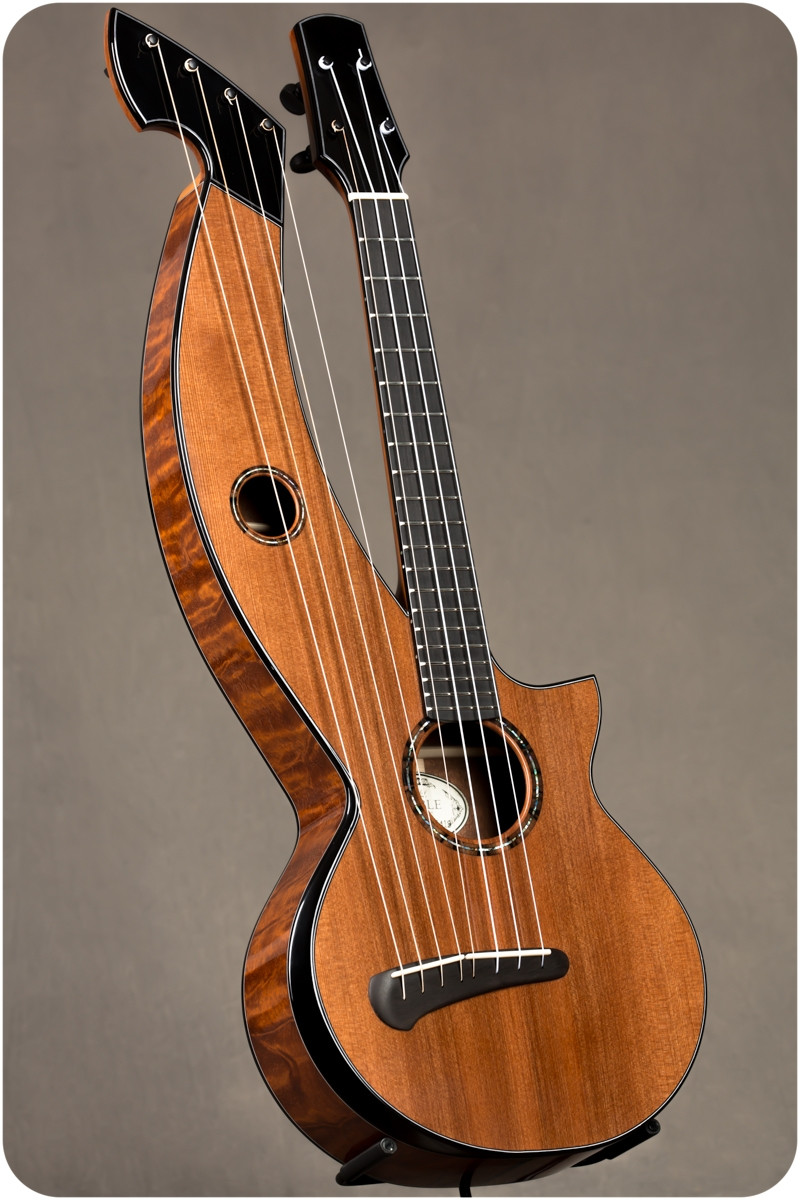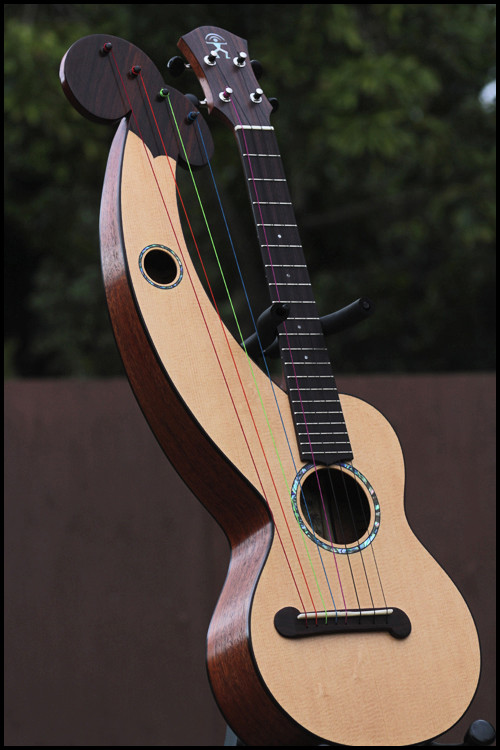A harp ukulele is a stringed instrument combining features of a traditional ukulele and a harp. It has added harp-like strings that are plucked, creating a unique tonal quality.
Delving into the world of stringed instruments unveils the captivating charm of the harp ukulele. Designed to enrich the auditory palette, the harp ukulele emerges as a melodic bridge between familiar and novel sounds. Its appearance might resemble a conventional ukulele at first glance, yet this instrument stands out with additional unrestricted strings that generate a resonant, harp-like reverberation.
From the hands of street performers to the stages of concert halls, the harp ukulele intrigues enthusiasts of music with its blend of simplicity and complexity. These extra strings not only embellish the musical range but also offer musicians the opportunity to explore expansive soundscapes unachievable with a standard ukulele, thus making the harp ukulele a vessel of innovation in contemporary acoustic music.
The Harp Ukulele Unveiled
Explore the enchanting world of the harp ukulele. This unique instrument blends traditional ukulele charm with the majestic resonance of a harp. As exotic as it sounds, the harp ukulele offers a melodic fusion impossible to ignore.
Origins And Evolution
The harp ukulele’s roots trace back to the early 20th century. Its invention stemmed from a quest for richer sound.
- Innovated by luthiers seeking new sonic horizons
- Combines ukulele joy with harp’s depth
- Gradual evolution led to diverse designs
- Gained a cult following among string enthusiasts
Design And Anatomy
The harp ukulele is a visual and auditory wonder. It’s more than just a ukulele with added strings. Each part contributes to its distinctive sound.
| Part | Function |
|---|---|
| Standard Ukulele Strings | For traditional play |
| Harp Strings | Provide harmonic accompaniment |
| Floating Soundboard | Enhances vibration and resonance |
| Extended Arm | Holds harp strings and adds length |
Every element from the headstock to the body is crafted to blend ukulele brightness with rich harp tones. This creates a full, captivating sound profile.

Credit: www.tonedevilharpguitars.com
Distinctive Features
The harp ukulele is no ordinary stringed instrument. It grabs attention with its unique aesthetic and sonic qualities. Combining features of a traditional ukulele and a harp, this hybrid offers players an expanded musical palette. Let’s delve into the characteristics that set it apart.
Comparison To Traditional Ukuleles
A traditional ukulele charms with its four nylon strings and compact size. The harp ukulele, however, adds a twist to this familiar design. With a glance, the differences are clear:
- Additional arms: A harp ukulele includes one or more extra arms, which accommodate bonus strings that are not fretted.
- More resonating space: The larger body provides a richer and more resonant sound.
- Varied sizes: They come in various sizes, inspired by soprano, concert, tenor, and baritone ukuleles.
Extra Strings And Tuning
The defining feature of a harp ukulele is undoubtedly its extra strings. These strings sit on a separate arm and are typically used for bass notes or sympathetic resonance. Depending on the model, a harp ukulele can have up to six additional strings, making its tuning a creative venture for any musician.
| String Type | Number | Function | Common Tuning |
|---|---|---|---|
| Fretted | 4 | Melody and Chords | G-C-E-A |
| Unfretted | 4-6 | Harmony and Bass | Varies |
Tuning the extra strings often follows a diatonic sequence or matches specific chord tones. This allows players to pluck harmonies or bass notes that complement the ukulele’s traditional sound.
Playing Techniques
Diving into the enchanting world of harp ukuleles brings a fresh perspective to string playing techniques. A harp ukulele player can produce a myriad of sounds, from soothing melodies to complex harmonies. Mastering this unique instrument involves understanding distinct playing techniques essential for bringing out its full potential. Let’s journey through these techniques to unlock the harp ukulele’s mesmerizing charm.
Fingering And Plucking
The foundation of playing a harp ukulele lies in precise fingering and plucking. The standard ukulele’s four strings plus the additional harp strings expand musical possibilities.
- Position your fingers: Use the tips for clarity.
- Assign fingers: Thumb plays top strings; index and middle fingers handle others.
Practice switching between strings. Start slow. Gain speed as your confidence grows.
Plucking requires a gentle yet firm touch. Mix fingerpicking patterns with strumming. This adds texture to the music.
Incorporating Harp Characteristics
The harp section of your instrument adds depth to your playing. The extended bass or treble strings resonate longer, producing a rich, harp-like sound.
- Play open strings: Let them ring. Create flowing harmonies.
- Leverage the sustain: Blend notes together for melody.
Combine regular ukulele techniques with the harp features. This unique fusion leads to captivating performances. Experiment with various harp and ukulele combinations. Discover your own style within these magical strings.

Credit: theukulelesite.com
Musical Genres And The Harp Ukulele
The harp ukulele, a fascinating hybrid instrument, blends the melodious charm of the ukulele with the rich resonance of the harp. This unique combination allows a spectrum of musical genres to shine, providing artists with the versatility to explore various sounds and styles.
Adaptability Across Styles
The harp ukulele’s design enables musicians to traverse a variety of musical landscapes. The additional harp strings offer expansive harmonic possibilities.
- Folk: A genre that embraces storytelling, the harp ukulele’s harmonic strings underscore narrative lyrics.
- Classical: The instrument’s range suits intricate compositions typically associated with classical pieces.
- Jazz: Jazz musicians appreciate the harp ukulele for its complex chords and improvisational potential.
Famous Compositions And Players
Few instruments match the harp ukulele’s distinctiveness in composition and performance.
| Player | Contribution |
|---|---|
| James Hill | Known for blending ukulele with diverse genres. |
| Gregoire Blanc | Creates mesmerizing classical music with his harp ukulele. |
| John King | Pioneer of the nylon-string ukulele for classical music. |
Inspirational compositions on the harp ukulele often become emblematic of the instrument’s potential. ‘The Dance of the Sugar Plum Fairy’ on a harp ukulele, exemplifies this idea. These players and their pieces foster a deep appreciation for the unique sounds of the harp ukulele.
Craftsmanship And Customization
Imagine a musical instrument that looks like a ukulele but sings with the depth of a harp. The harp ukulele is a hybrid that marries the familiar body of a ukulele with the added resonance of harp-like strings. Craftsmanship and customization are what make each harp ukulele not only a tool for creating music but also a piece of art.
Luthiers And Brands
The creation of a harp ukulele is a testament to the skill of luthiers—these are the craftsmen who build stringed instruments by hand. Every curve and line of a harp ukulele reflects the maker’s commitment to quality. The selection of wood, the precision in shaping the instrument, and the intricacies of adding the extra strings all demonstrate the luthier’s artistry.
- Notable Brands: From Kinnard to Anuenue, each brand offers unique touches.
- Quality Woods: Choices range from koa to spruce, influencing the instrument’s tone.
- Handcrafted Design: Luthiers ensure that each instrument stands out.
Personalizing Your Instrument
For those who seek a more personal connection with their instrument, customization is key. You might choose the wood type or request specific inlays that have meaning to you. From the tuning pegs to the finish of the wood, every element can reflect your personality.
- Select your preferred wood type for a custom sound.
- Choose inlays or engravings that represent your style.
- Decide on the string arrangement for a truly unique play.

Credit: theukulelesite.com
Acquiring A Harp Ukulele
Embark on a musical journey with the harp ukulele! This unique instrument combines classic ukulele play with the rich tones of a harp. Perfect for musicians seeking a distinctive sound. Find your harp ukulele and create enchanting music that captivates.
Where To Purchase
Ready to own a harp ukulele? Explore these options for a smooth purchase:
- Music Stores: Visit local shops for a hands-on experience.
- Online Retailers: Browse extensive collections from comfort.
- Custom Builders: Order a one-of-a-kind harp ukulele.
- Secondhand Marketplaces: Hunt for hidden treasures.
Start your search in music stores to feel the instrument firsthand. For convenience, turn to online retailers with wide selections. Custom builders provide personalized options. Explore secondhand marketplaces for potential savings and unique finds.
Considerations For Buyers
Keep these crucial points in mind while shopping:
- Tone Quality: Ensure rich, clear harp resonance.
- Craftsmanship: Opt for sturdy build and finish.
- Playability: Check for comfortable string spacing.
- Size: Pick one that suits your holding style.
- Budget: Set a spending limit before exploring.
Note the quality of the tone; a clear, rich sound is vital. Craftsmanship affects durability and aesthetics. Playability includes the comfort of string spacing. Choose a size that feels right in your hands. Plan your budget to streamline the search process.
What is the Difference Between a Harp Ukulele and a Banjo Ukulele?
A harp ukulele features extra bass strings and a larger body, giving it a fuller sound with a unique resonance. On the other hand, a banjo ukulele explained here has a distinctive twangy tone thanks to its resonator and drum-like body. Both offer a unique and versatile playing experience.
Frequently Asked Questions For What Is A Harp Ukulele
What Is The Point Of A Harp Guitar?
The harp guitar extends the range of traditional guitars, offering additional bass or treble strings for broader musical expression. It enables enhanced acoustic capabilities and greater creative possibilities for composers and players.
What Is The Difference Between Ukulele And Guitar Strings?
Ukulele strings are typically made from nylon, while guitar strings commonly use steel for acoustic and electric, or nylon for classical guitars. Ukuleles have four strings, whereas most guitars have six, resulting in distinct sounds and tuning.
What Does Ukulele Mean Guitar?
The term “ukulele” does not mean “guitar”. It refers to a small, four-stringed Hawaiian instrument, similar to but distinct from the guitar.
What Is A Harp Ukulele?
A harp ukulele is a unique stringed instrument combining traditional ukulele with additional unfretted strings, resembling those of a harp. It offers a wider range of notes and harmonic richness, beyond the standard ukulele.
Conclusion
Discovering the harp ukulele’s enchanting blend of tones can transform your musical journey. This unique instrument offers a rich harmonic range for both beginners and seasoned players. As you explore its distinct sound, the harp ukulele stands ready to inspire your creativity and enhance your repertoire.
Embrace this captivating fusion, and let your melodies soar.
